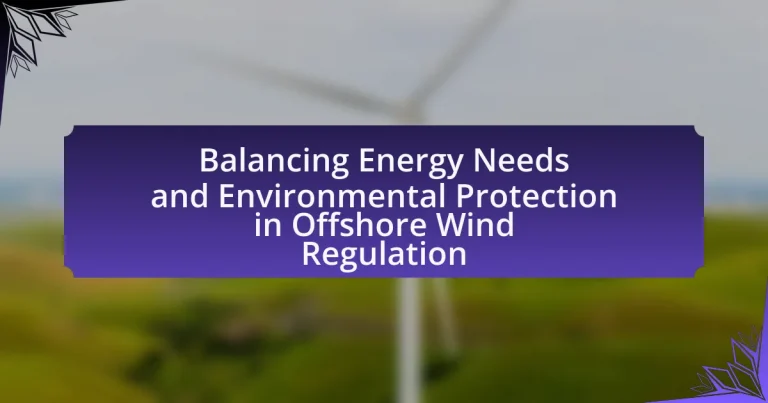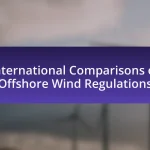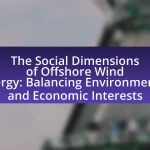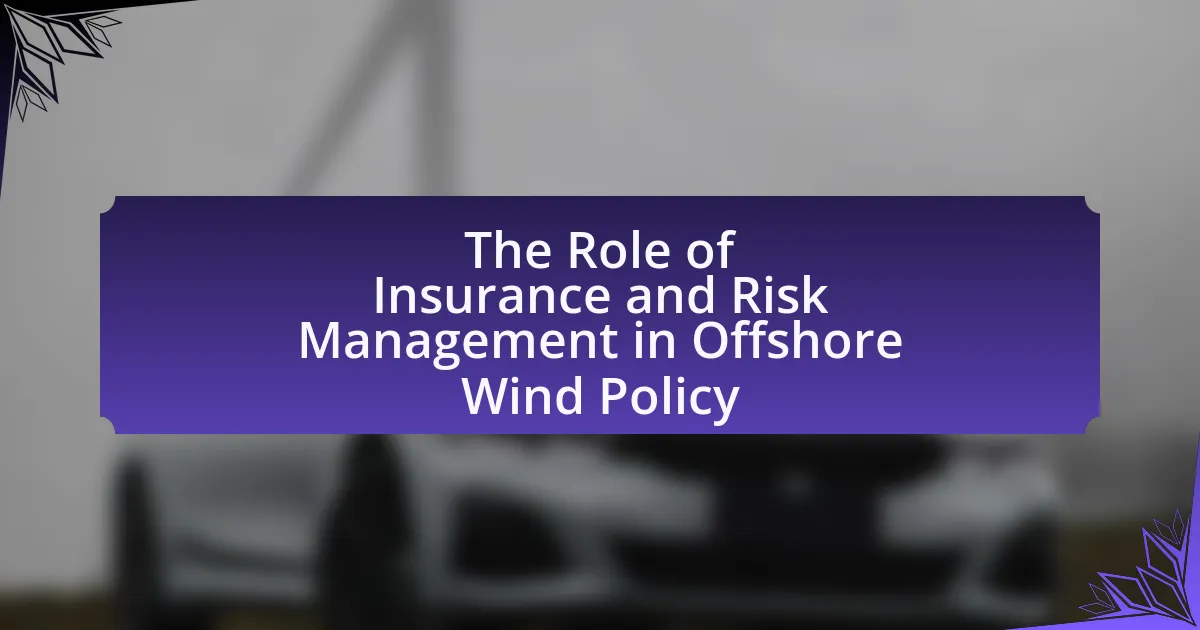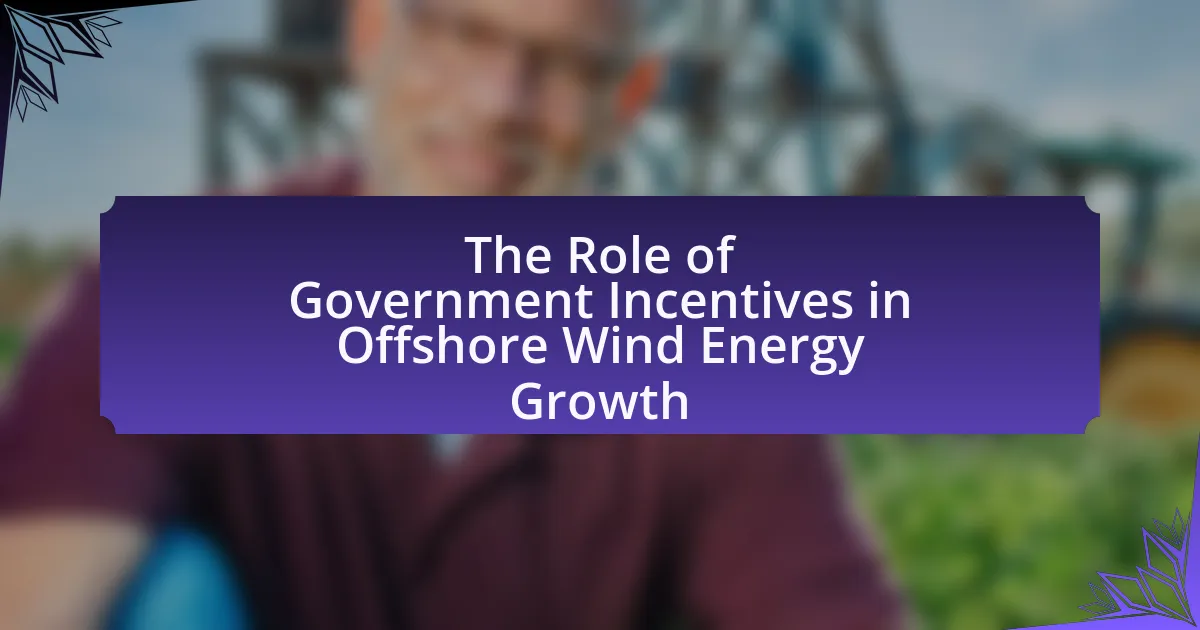The article focuses on the critical balance between energy needs and environmental protection in the regulation of offshore wind energy. It outlines key considerations such as ecological impact assessments, stakeholder engagement, and technological advancements that influence regulatory frameworks. The discussion includes the driving energy demands for renewable sources, the environmental concerns associated with offshore wind projects, and the regulatory approaches adopted by different countries. Additionally, it highlights the importance of collaboration among stakeholders and the role of innovation in shaping future policies, ultimately emphasizing the need for sustainable development in offshore wind energy while safeguarding marine ecosystems.
What are the key considerations in balancing energy needs and environmental protection in offshore wind regulation?
Key considerations in balancing energy needs and environmental protection in offshore wind regulation include the assessment of ecological impacts, stakeholder engagement, and technological advancements. Ecological impact assessments are crucial to understand how wind farms affect marine life, bird migration patterns, and local ecosystems. Stakeholder engagement ensures that the interests of local communities, environmental groups, and industry stakeholders are considered, fostering a collaborative approach to regulation. Technological advancements, such as improved turbine designs and energy storage solutions, can enhance energy efficiency while minimizing environmental footprints. These considerations are essential for creating regulations that support sustainable energy development without compromising environmental integrity.
How do energy needs influence offshore wind regulation?
Energy needs significantly influence offshore wind regulation by driving policy decisions that prioritize renewable energy development to meet growing electricity demands. As countries aim to reduce carbon emissions and transition to sustainable energy sources, regulations are often designed to facilitate the deployment of offshore wind farms, which are seen as a crucial component in achieving energy targets. For instance, the European Union has set ambitious goals to increase offshore wind capacity to 300 GW by 2030, reflecting the urgent need for clean energy to support economic growth and energy security. This regulatory framework not only encourages investment in offshore wind projects but also establishes guidelines to balance energy production with environmental protection, ensuring that ecological impacts are considered while meeting energy demands.
What are the current energy demands driving offshore wind development?
The current energy demands driving offshore wind development include the need for renewable energy sources to combat climate change and reduce greenhouse gas emissions. As countries aim to meet international climate targets, such as those outlined in the Paris Agreement, there is a significant push towards increasing the share of renewable energy in their energy mix. For instance, the International Energy Agency reported that global offshore wind capacity is expected to grow from 35 gigawatts in 2020 to over 200 gigawatts by 2030, reflecting a strong demand for cleaner energy alternatives. Additionally, the rising electricity consumption due to electrification of sectors like transportation and heating further intensifies the need for sustainable energy solutions, making offshore wind a critical component in achieving energy security and sustainability goals.
How does offshore wind energy contribute to meeting these energy demands?
Offshore wind energy significantly contributes to meeting energy demands by providing a renewable and sustainable source of electricity. This form of energy generation harnesses strong and consistent winds over oceans, which can produce large amounts of power, often exceeding that of onshore wind farms. For instance, a single offshore wind turbine can generate enough electricity to power thousands of homes, with projects like the Hornsea One in the UK capable of supplying energy to over one million households. Additionally, offshore wind energy helps reduce reliance on fossil fuels, thereby decreasing greenhouse gas emissions and supporting climate goals. The International Energy Agency reported that offshore wind capacity could reach 200 gigawatts globally by 2030, highlighting its potential to play a crucial role in future energy systems.
What environmental concerns arise from offshore wind projects?
Offshore wind projects raise several environmental concerns, primarily related to marine ecosystems, bird and bat mortality, and underwater noise pollution. The construction and operation of wind turbines can disrupt local habitats, affecting species such as fish and marine mammals. Studies indicate that the installation of wind farms can lead to increased mortality rates for birds and bats due to collisions with turbine blades; for instance, research published in the journal “Ecology and Evolution” highlights that certain species are particularly vulnerable during migration. Additionally, underwater noise generated during construction can interfere with marine life communication and navigation, impacting species like whales and dolphins. These concerns necessitate careful planning and regulation to mitigate environmental impacts while pursuing renewable energy goals.
How do offshore wind farms impact marine ecosystems?
Offshore wind farms impact marine ecosystems primarily by altering habitats and affecting local wildlife. The construction and operation of these farms can lead to changes in seabed composition, which may disrupt benthic organisms and their habitats. Additionally, the presence of turbines can create artificial reefs, potentially benefiting some species while posing risks to others, such as migratory fish and marine mammals that may avoid these areas due to noise and movement. Studies have shown that the installation of wind farms can lead to changes in species distribution and abundance, as evidenced by research conducted by the University of Rhode Island, which found that certain fish populations increased around wind farm structures.
What are the potential effects on local wildlife and habitats?
The potential effects on local wildlife and habitats from offshore wind regulation include habitat disruption, changes in species behavior, and potential mortality from turbine interactions. Habitat disruption occurs during the construction and operation phases, which can lead to the displacement of marine species and alteration of local ecosystems. For example, studies have shown that the installation of wind turbines can affect fish populations by changing the availability of breeding grounds. Additionally, species such as birds and bats may experience increased mortality rates due to collisions with turbine blades, as evidenced by research indicating that certain migratory bird species are particularly vulnerable in areas with high turbine density. Overall, while offshore wind energy contributes to renewable energy goals, careful consideration of its impacts on local wildlife and habitats is essential for effective environmental protection.
What regulatory frameworks exist for offshore wind energy?
Regulatory frameworks for offshore wind energy include national legislation, international agreements, and specific permitting processes. In the United States, the Bureau of Ocean Energy Management (BOEM) oversees leasing and environmental reviews, while the European Union has established directives such as the Renewable Energy Directive and the Offshore Renewable Energy Strategy to promote offshore wind development. Additionally, countries like the United Kingdom implement frameworks like the Energy Act and the Marine and Coastal Access Act, which set out licensing and environmental assessment requirements. These frameworks aim to balance energy production with environmental protection by ensuring compliance with environmental standards and stakeholder engagement.
How do different countries approach offshore wind regulation?
Different countries approach offshore wind regulation through a combination of national policies, permitting processes, and environmental assessments. For instance, the United Kingdom has established a comprehensive regulatory framework that includes the Offshore Wind Sector Deal, which aims to streamline planning and enhance investment in offshore wind projects. In contrast, Germany employs a feed-in tariff system that guarantees fixed payments for electricity generated from offshore wind, promoting investment while ensuring environmental standards are met. The United States, on the other hand, has a more decentralized approach, with states like Massachusetts and New York implementing their own regulations while the federal government oversees leasing and environmental reviews. These varied approaches reflect each country’s unique energy needs, regulatory environments, and commitment to environmental protection.
What role do international agreements play in offshore wind governance?
International agreements play a crucial role in offshore wind governance by establishing frameworks for cooperation, regulatory standards, and environmental protection. These agreements, such as the Paris Agreement and regional initiatives like the North Sea Wind Power Hub, facilitate collaboration among countries to share best practices, harmonize regulations, and set ambitious renewable energy targets. For instance, the North Sea Wind Power Hub aims to connect multiple countries’ offshore wind farms, enhancing energy security and reducing costs through shared infrastructure. Such international frameworks ensure that offshore wind development aligns with environmental sustainability goals, promoting responsible use of marine resources while addressing climate change.
How can stakeholders effectively balance energy production and environmental protection?
Stakeholders can effectively balance energy production and environmental protection by implementing integrated planning processes that consider both energy needs and ecological impacts. This approach involves collaboration among government agencies, energy producers, environmental organizations, and local communities to establish guidelines that prioritize sustainable practices. For instance, the European Union’s Renewable Energy Directive emphasizes the importance of environmental assessments in the planning stages of energy projects, ensuring that potential ecological consequences are evaluated and mitigated. Additionally, adopting technologies such as offshore wind turbines designed to minimize harm to marine life can further support this balance, as evidenced by studies showing reduced bird and bat fatalities with specific turbine designs.
What strategies can be employed to minimize environmental impact?
To minimize environmental impact in offshore wind regulation, strategies such as implementing rigorous environmental assessments, utilizing advanced turbine technology, and establishing protective marine zones can be employed. Rigorous environmental assessments ensure that potential impacts on marine ecosystems are identified and mitigated before project approval. Advanced turbine technology, including quieter and more efficient designs, reduces noise pollution and minimizes harm to wildlife. Establishing protective marine zones helps safeguard critical habitats and migratory routes, thereby preserving biodiversity. These strategies collectively contribute to a more sustainable approach to offshore wind energy development.
How can technology be leveraged to reduce ecological footprints?
Technology can be leveraged to reduce ecological footprints by implementing advanced energy management systems and optimizing resource use. For instance, smart grids enhance energy efficiency by allowing real-time monitoring and management of energy consumption, which can lead to a reduction in greenhouse gas emissions. Additionally, renewable energy technologies, such as offshore wind turbines, produce clean energy that minimizes reliance on fossil fuels, thereby decreasing overall ecological impact. According to the International Renewable Energy Agency, transitioning to renewable energy sources could reduce global carbon emissions by up to 70% by 2050. Furthermore, innovations in materials science, such as biodegradable composites, can lessen waste and pollution associated with traditional manufacturing processes.
What best practices exist for site selection and project design?
Best practices for site selection and project design in offshore wind regulation include conducting thorough environmental impact assessments, engaging with local communities, and utilizing advanced modeling techniques to predict ecological effects. Environmental impact assessments ensure that potential risks to marine life and habitats are identified and mitigated, as evidenced by studies showing reduced biodiversity loss when these assessments are implemented. Engaging with local communities fosters transparency and addresses stakeholder concerns, which has been shown to enhance project acceptance and reduce conflicts. Advanced modeling techniques, such as GIS mapping and simulation tools, allow for informed decision-making regarding site suitability, optimizing energy production while minimizing ecological disruption.
How do stakeholder interests shape offshore wind regulation?
Stakeholder interests significantly shape offshore wind regulation by influencing policy decisions and regulatory frameworks. Various stakeholders, including government agencies, environmental groups, local communities, and energy companies, advocate for their specific interests, which can lead to a balance between energy production and environmental protection. For instance, environmental organizations often push for stringent regulations to protect marine ecosystems, while energy companies may lobby for more favorable conditions to facilitate project development. This dynamic interaction results in regulations that aim to address both the need for renewable energy and the preservation of ecological integrity, as seen in the establishment of guidelines that require environmental impact assessments before project approval.
What roles do government, industry, and environmental groups play?
Government, industry, and environmental groups each play crucial roles in balancing energy needs and environmental protection in offshore wind regulation. The government establishes regulations and policies that guide the development and operation of offshore wind projects, ensuring compliance with environmental standards and promoting sustainable energy practices. Industry stakeholders, including energy companies, are responsible for the design, construction, and maintenance of offshore wind farms, driving innovation and investment in renewable energy technologies. Environmental groups advocate for the protection of marine ecosystems and biodiversity, influencing policy decisions and raising public awareness about the potential impacts of offshore wind development. Together, these entities collaborate to create a framework that supports renewable energy growth while safeguarding environmental interests.
How can collaboration among stakeholders enhance regulatory outcomes?
Collaboration among stakeholders can enhance regulatory outcomes by fostering a comprehensive understanding of diverse perspectives and expertise. When stakeholders, including government agencies, industry representatives, environmental groups, and local communities, work together, they can identify potential regulatory challenges and opportunities more effectively. This collaborative approach leads to more informed decision-making, as evidenced by the success of multi-stakeholder initiatives in offshore wind projects, which have resulted in streamlined permitting processes and reduced conflicts. For instance, the Bureau of Ocean Energy Management reported that stakeholder engagement in offshore wind development has led to improved environmental assessments and more robust regulatory frameworks, ultimately balancing energy needs with environmental protection.
What are the future trends in offshore wind regulation and environmental protection?
Future trends in offshore wind regulation and environmental protection include increased integration of environmental impact assessments (EIAs) into the planning process and the adoption of more stringent sustainability criteria. Regulatory frameworks are evolving to prioritize biodiversity conservation, with specific measures aimed at minimizing the ecological footprint of wind farms. For instance, the European Union’s Green Deal emphasizes the need for comprehensive environmental monitoring and adaptive management strategies to address potential impacts on marine ecosystems. Additionally, advancements in technology, such as the use of remote sensing and data analytics, are enhancing the ability to assess and mitigate environmental risks associated with offshore wind projects. These trends reflect a growing recognition of the need to balance energy production with environmental stewardship, ensuring that offshore wind development contributes to both climate goals and the protection of marine habitats.
How is innovation influencing offshore wind energy policies?
Innovation is significantly influencing offshore wind energy policies by driving advancements in technology and efficiency, which in turn shape regulatory frameworks. For instance, the development of larger and more efficient turbines has led to increased energy output, prompting policymakers to adjust capacity targets and incentives to align with these technological improvements. Additionally, innovations in floating wind farm technology are expanding the geographical feasibility of offshore wind projects, necessitating new policies that address environmental impacts and maritime spatial planning. These changes are supported by data showing that offshore wind capacity has grown exponentially, with global installations reaching over 35 gigawatts by 2020, reflecting the need for adaptive regulatory measures that balance energy production with environmental protection.
What emerging technologies are expected to impact offshore wind regulation?
Emerging technologies expected to impact offshore wind regulation include advanced data analytics, artificial intelligence (AI), and remote sensing technologies. Advanced data analytics enhances decision-making by providing real-time insights into environmental impacts and operational efficiency, which can lead to more informed regulatory frameworks. AI can optimize turbine performance and predict maintenance needs, thereby influencing regulatory standards for operational reliability and safety. Remote sensing technologies, such as satellite imagery and drones, improve monitoring of environmental conditions and compliance with regulations, facilitating better management of offshore wind projects. These technologies collectively support the balance between energy production and environmental protection by ensuring that regulations are based on accurate, timely data.
How can adaptive management practices improve regulatory frameworks?
Adaptive management practices can improve regulatory frameworks by enabling a flexible and iterative approach to decision-making that incorporates real-time data and stakeholder feedback. This adaptability allows regulators to respond effectively to changing environmental conditions and technological advancements, ensuring that regulations remain relevant and effective. For instance, in the context of offshore wind regulation, adaptive management can facilitate the integration of new scientific findings about marine ecosystems, leading to more informed and sustainable energy policies. Studies have shown that adaptive management enhances compliance and reduces conflicts among stakeholders by fostering collaboration and transparency, ultimately leading to better environmental outcomes while meeting energy needs.
What lessons can be learned from existing offshore wind projects?
Existing offshore wind projects demonstrate the importance of stakeholder engagement and environmental assessments in project planning. Effective communication with local communities and environmental groups has been shown to mitigate opposition and enhance project acceptance, as evidenced by the successful deployment of the Hornsea One project in the UK, which involved extensive consultations. Additionally, these projects highlight the necessity of adaptive management strategies to address unforeseen environmental impacts, as seen in the Block Island Wind Farm, where ongoing monitoring led to adjustments in operational practices to protect local wildlife. Furthermore, the economic viability of offshore wind has been reinforced through cost reductions achieved via technological advancements and economies of scale, illustrated by the declining costs of offshore wind energy in Europe, which fell by 48% between 2010 and 2019.
What case studies illustrate successful balancing of energy and environmental needs?
Case studies that illustrate successful balancing of energy and environmental needs include the Block Island Wind Farm in the United States and the Horns Rev offshore wind farm in Denmark. The Block Island Wind Farm, operational since 2016, is the first commercial offshore wind farm in the U.S. and has demonstrated a commitment to environmental protection by incorporating measures to minimize impacts on local marine life, such as careful site selection and monitoring programs. The Horns Rev project, which began operations in 2002, has effectively balanced energy production with environmental considerations by conducting extensive environmental assessments prior to development and implementing strategies to protect local ecosystems, resulting in a significant increase in renewable energy generation while maintaining biodiversity. These case studies provide concrete examples of how offshore wind projects can achieve both energy and environmental goals through careful planning and management.
How can past challenges inform future regulatory approaches?
Past challenges in offshore wind regulation can inform future regulatory approaches by highlighting the need for adaptive frameworks that address both energy demands and environmental protection. For instance, previous regulatory hurdles, such as delays in permitting processes due to environmental concerns, have shown that integrating stakeholder input early can streamline approvals and enhance compliance. The experience from the Cape Wind project, which faced significant opposition and regulatory delays, underscores the importance of transparent communication and collaboration with local communities and environmental groups. This historical context demonstrates that future regulations should incorporate lessons learned to create more efficient, responsive, and balanced regulatory frameworks that effectively manage both energy production and ecological preservation.
What practical steps can be taken to enhance offshore wind regulation?
To enhance offshore wind regulation, implementing standardized permitting processes is essential. Streamlining these processes can reduce delays and uncertainties for developers, facilitating faster project approvals. Additionally, establishing clear environmental impact assessment guidelines ensures that ecological considerations are integrated into project planning. For instance, the European Union’s Offshore Renewable Energy Strategy emphasizes the need for harmonized regulations across member states to promote investment and innovation in offshore wind. Furthermore, fostering collaboration between government agencies, industry stakeholders, and environmental organizations can lead to more effective regulatory frameworks that balance energy production with environmental protection.
How can policymakers ensure sustainable development in offshore wind energy?
Policymakers can ensure sustainable development in offshore wind energy by implementing comprehensive regulatory frameworks that prioritize environmental protection while facilitating energy production. These frameworks should include rigorous environmental impact assessments, stakeholder engagement processes, and adaptive management strategies to monitor and mitigate ecological impacts. For instance, the European Union’s Offshore Renewable Energy Strategy emphasizes the importance of balancing energy needs with biodiversity conservation, aiming for a 300% increase in offshore wind capacity by 2050 while safeguarding marine ecosystems. This approach demonstrates that effective policy can drive sustainable offshore wind development while addressing environmental concerns.
What role does public engagement play in shaping effective regulations?
Public engagement plays a crucial role in shaping effective regulations by ensuring that diverse stakeholder perspectives are considered in the regulatory process. Engaging the public allows regulators to gather valuable insights, identify potential concerns, and enhance the legitimacy of regulations. For instance, studies have shown that public participation in environmental decision-making leads to more informed and balanced outcomes, as evidenced by the increased acceptance of offshore wind projects when local communities are involved in the planning stages. This involvement not only fosters transparency but also helps to align regulatory frameworks with the actual needs and values of the community, ultimately leading to more sustainable and effective regulations.
